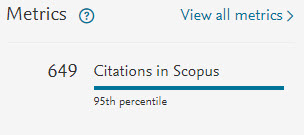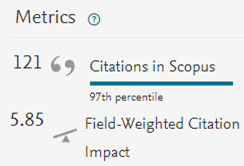Article level metrics measure the reach and citation impact of individual articles. They can demonstrate impact whether or not you have a small or large body of work and highlight your most impactful outputs.
You can use a combination of indices from different platforms to demonstrate the citation uptake of your research. Which tool you use and which figures work best for you will depend on your discipline, the stage of your research career and the type of research output you commonly publish.
Types of Article Metrics
Citation Count
This is the number of indexed citations of your publications on a particular database. An article's citations increase with the age of the paper, so older publications will perform strongly whilst more recent publications will have had less time to accrue citations. Similarly, any research from an early career academic or research that is in the early stages of a new strategy may take a longer time to accrue citations.

Considerations
- Remember that InCites only analyses data about Web of Science-indexed content; SciVal only analyses data about Scopus-indexed content.
- STEM research areas tend to have higher publishing and citation practices than the Social Sciences and Humanities disciplines. It is therefore not appropriate to compare citation counts across disciplines, as publishing norms and database coverage of these disciplines varies. You should consider using field normalised metrics as a companion metric if this is an issue.
Field Normalised Metrics
Field Normalised Citation Impact
Field Normalised Citation Impact is used to measure the citation performance of your article against the global average for your field. It allows for the differences between disciplines, type of published output and the expected lower citation rates on your most recent publications.
Category Normalised Citation Impact
In the Clarivate/InCites platform, this is called the Category Normalised Citation Impact (CNCI). InCites reports the CNCI of each article related to the average citation for the field in which the article was published. CNCI can also be reported as an author-level metric by applying the calculation to a set of documents.
 Field-Weighted Citation Impact
Field-Weighted Citation Impact
In the Elsevier/Scival platform, this is called the Field-Weighted Citation Impact (FWCI). SciVal reports the FWCI for each individual article against the field average of the assigned subject codes for the journal in which your article was published. FWCI can also be reported as an author-level metric by applying the calculation to a set of documents.
How is it calculated?
Field Normalised Citation Impact at an article level compares the number of citations received by your publication to the average number of citations received by similar publications.
- 1.00 indicates that your article has been cited as expected based on the global average for similar publications.
- more than 1.00 indicates that your article has been cited more than the global average for similar publications.
- less than 1.00 indicates that your article has been cited less than the global average for similar publications.
For example, 2.11 means 111% more than the world average and 0.87 means 13% less than the global average.
Considerations
- Remember that InCites only analyses data from Web of Science-indexed content; SciVal only analyses data within Scopus-indexed content only.
- If your aim is to demonstrate the high number of citations you work has received, the Field Normalised Citation Impact may actually make your figures appear lower once the weighting has been applied. Similarly, if your discipline has typically lower citation rates, the Field Normalised Citation Impact may appear higher after the field weighting.
- It can assist in explaining a relatively low citation rate by demonstrating that the field average is similarly low and can explain very high citation rates in highly cited fields. This overcomes any database bias towards STEM disciplines and their higher citation rates. It should not be used on its own or as a direct measure of research quality.
Sources of article-level metrics
- Google Scholar
Use to find citation count. Harzing's Publish or Perish software may be used for analysing Google Scholar metrics data. - InCites: Benchmarking & Analytics
Use to find citation count; Category Normalised Citation Impact (CNCI) for individual articles and the overall researcher. - SciVal
Use to find citation count; Field-Weighted Citation Impact (FWCI) for individual articles and the overall researcher. - Scopus
Use to find citation count; Field-Weighted Citation Impact (FWCI) for individual articles. - Web of Science
Use to find citation count.